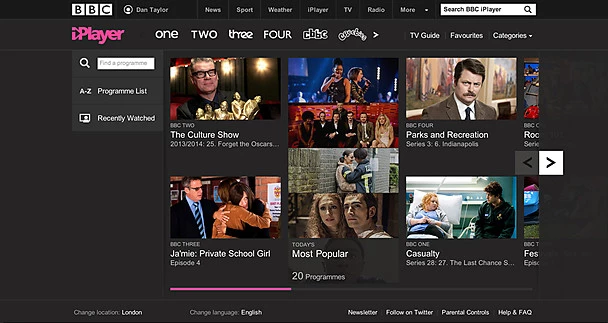The BBC's online TV catch-up platform, iPlayer, was launched on Christmas Day 2007. Since then it has been through a number of iterations and now serves 10 million program requests daily. Today, the Beeb has announced the latest update to the iPlayer.
Updates to BBC websites and platforms are closely watched due to the high standards of best practice they follow. They are also often a benchmark of prevailing design trends at the time. The new design focuses primarily on device compatibility and program discovery. The iPlayer is viewable in the UK only, but BBC Worldwide has rolled out a global version to a number of countries.
"The new iPlayer has been designed for a multiscreen world," says BBC's Head of iPlayer Dan Taylor in a blog post. "So the experience is consistent, but optimized across PC, tablet, mobile and TV devices and we've built it in such a way that we can rapidly develop and release new features across those four screens."
The website version is built using responsive design, to ensure that it can be viewed on any screen size or device. A range of device-specific iPlayer apps are available for a tailored experience on a user's chosen device and the organization plans to roll-out a new version of each app over the coming months.
An increased focus has also be placed on making it easy for users to find programs to watch, whether they are visiting the platform with a something specific in mind or they are just browsing. According to the BBC, 42 percent of visitors to iPlayer do not have a specific program in mind.

For users who do know what they want to view, a variety of "find tools" are available. An improved search function provides suggestions as users type in a program name, an A-Z list of programs is offered, and a recently watched section shows the user's viewing history.
Among the other updates to the iPlayer is a new home screen that the BBC says is aimed at, "being simpler, more visual and easier to browse." It provides a more image-based browsing experience and a new navigation bar. Information about programs is provided with hover-over functionality.
Each BBC channel has an index page of its own, into which the image-based browsing approach is also pulled. The categories offered have been developed to provide more meaningful subject titles, and a collections feature has been added so that related groups of programs can be pulled together for visitors.

The playback page itself has been reshaped to provide users with more options for what they want to do before, during and after viewing. Before viewing, users are presented with relevant information and other program episodes. Playback itself uses the BBC’s new Standard Media Player for which plugins can be developed. An example given is the ability for users to add a program to their favorites without leaving the playback mode. After a program has finished, the next episode is automatically lined up and users are given a variety of recommendations using an updated recommendation engine.
The new version of iPlayer also features some updated accessibility features. Visual cues and clear headings are used to cater for partially-sighted and blind users, and the Standard Media Player supports keyboard-only users, screen reader users and voice input users. Audio description, signed and subtitled content is provided, with subtitles easily toggled.
Along with the updated design, the BBC has announced plans to increase the standard availability timeframe from 7 to 30 days. It has also announced a number of iPlayer commissions, including drama and comedy shorts, as well as other arts and culture content.
The new version of BBC iPlayer will begin rolling out today.
Source: BBC












